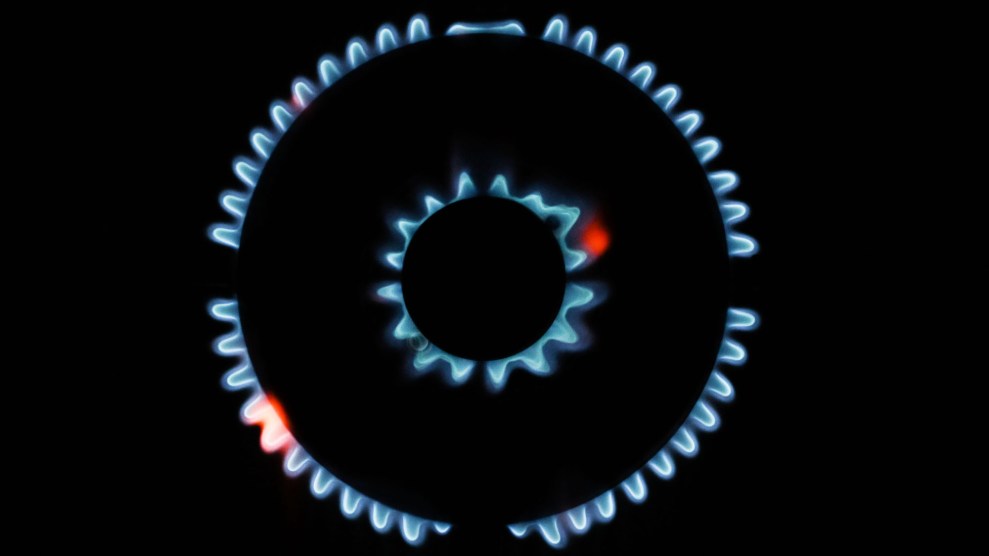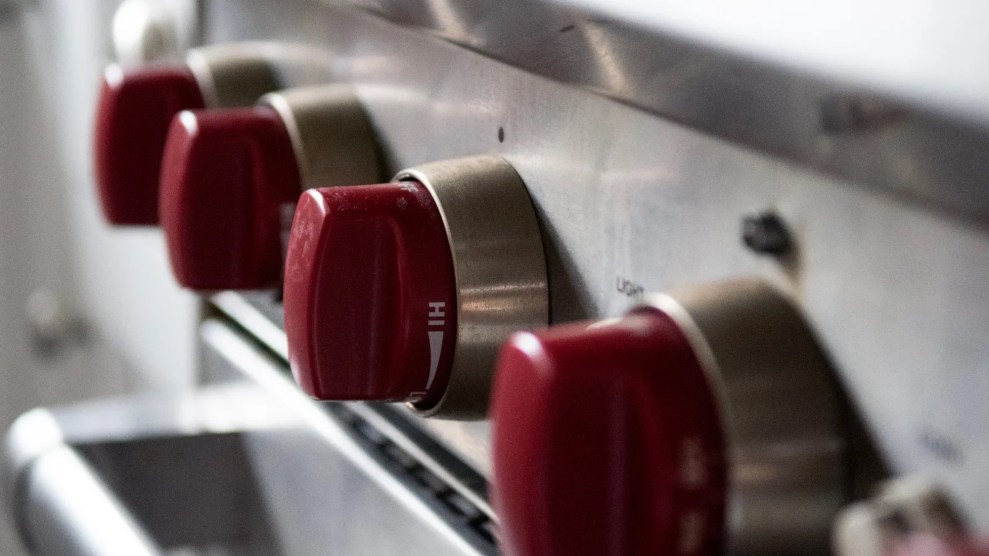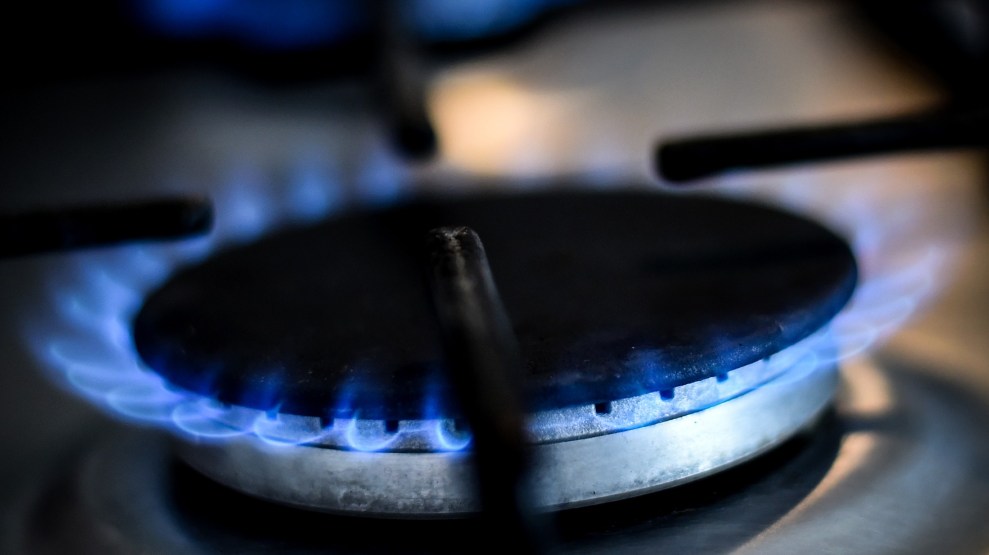
Marijan Murat/dpa/Zuma
This story was originally published by Slate and appears here as part of the Climate Desk collaboration.
The winter between 1917 and 1918 was a trying one for the gas industry. That year, household gas leaks had reportedly killed more than 300 New Yorkers—due to their own carelessness, the gas companies argued. But not everyone was convinced. Consumers were also upset over rate increases, inequitable access, and inconsistent delivery; they filed more than a thousand complaints about gas quality and pressure.
In the midst of these battles, in June 1918, the American Gas Association was born. Launched by gas utilities and appliance makers, the industrywide trade group quickly proposed an advertising arm. Better information, the case went, would help counter “undeserved criticism.”
Today, most investor-owned gas utilities in the U.S., along with many publicly owned ones, are members of the AGA, and the trade group has worked to make gas poisonings much more rare. Coordinating safety efforts across American utilities, the group notes, is one of its key priorities. But over the past 100 years, the AGA has also—in coordination with its members and other industry trade groups—dedicated significant resources to marketing ideas like Gas is better for cooking; Gas stoves don’t significantly impact health; and Natural gas is an important tool for climate progress.
That marketing has gained more relevance over the past year, as the debate over gas stoves has picked up steam. In case you need a refresher: Last December, a study funded by the Rocky Mountain Institute and the National Cancer Institute estimated that gas stoves are a risk factor for childhood asthma about on par with exposure to secondhand smoke. Shortly after, a commissioner from the US Consumer Product Safety Commission said in an interview that “products that can’t be made safe can be banned.” The commission chair later clarified that the commission was not seeking a ban on gas stoves, but the mere specter of one was enough to spark plenty of “don’t-touch-my-kitchen” outrage—and the issue quickly devolved into a political maelstrom. (Culminating in, among other things, the House passing the “Gas Stove Protection and Freedom Act.”)
This whole culture-war mess has done a fairly good job of distorting a pretty straightforward truth: Gas is not the best option for our health, and it’s especially not the best option for the planet. Just last week, delegates at the UN’s COP28 conference finally agreed to transition away from fossil fuels like gas by 2050. They didn’t agree on all the particulars, but to keep global warming under 1.5 degrees Celsius, according to the International Energy Agency, demand for natural gas needs to fall by more than half by 2050. The IEA’s roadmap to get there assumes a move away from household gas, which is foundational to gas utilities’ business model—the very business model gas trade groups like the AGA are tasked with protecting.
Trade groups, of course, influence public opinion and legislation in virtually every industry, so on its face there’s nothing surprising about the AGA’s efforts. But while consumers can choose not to support brands they don’t agree with, it is harder to stop paying your gas bills. What many Americans may not know is that a portion of ratepayer fees are often directed toward funding energy trade groups—which means that if you heat your home or cook with gas, your bills may be funding efforts to keep gas demand high.
To understand how, let’s take a step back. According to the AGA, 96 percent of American gas customers get their gas from AGA member utilities. These utilities have shareholders—either private investors or the public—and they have ratepayers: captive customers who can’t easily get their gas somewhere else. As regulated monopolies, US utilities are meant to act in the public interest (perhaps … a livable planet?). This means they can’t legally spend ratepayer money on specific types of lobbying (they use shareholder money for that instead). But they can and do spend utility bill revenue on other tactics designed to maintain natural gas market share.
They do this, in part, by paying dues to the AGA. In recent years, the AGA has boasted around 200 members and annual budgets between $30 and $60 million. It has, among other tactics, hired influencers to wax poetic about #cookingwithgas, opposed local legislation that would limit gas hookups in new developments, and funded research to sow doubt over the health and environmental effects of its product.
One of the AGA’s particularly important areas of influence is in rulemaking—the wonky but high-stakes process through which government agencies regulate everything from Energy Star labels to clean air. In May, for example, the AGA argued that new energy efficiency standards were stacked against gas stoves, splitting hairs over the water quantity and pan diameters. These may seem like mundane details, but they determine outcomes that shape consumer behavior and the AGA comments on hundreds of similar regulations. In August, the group argued against “advanced leak detection” for pipeline leaks, noting it was “very concerned” with how the federal pipeline regulator was “prioritizing climate concerns to be on par with pipeline safety.”
The AGA has similarly invested in influencing legislation. AGA meeting minutes from 2020, obtained by the Climate Investigations Center (and previously reported by Vox and NPR), noted that local gas company PR campaigns were, at the time, suffering from a “leadership gap.” The trade association promised to step up its coordination role. It also took credit for legislation passed in Arizona that barred local governments from banning gas hookups in new construction. Since then, anti-gas-ban bills have passed in 20 states. Earlier this year, when gas stoves popped up in the news, the AGA sprang into action—among other responses, the organization hired a scientist to comment on an American Medical Association resolution that urged doctors to educate their patients about gas stove health risks.
One of the gas lobby’s tactics is to greenwash natural gas by focusing on the health and environmental drawbacks of other fuels, without mentioning the health and environmental drawbacks of gas. The AGA calls natural gas “the earth’s cleanest traditional fuel”—as in, It’s better than coal and oil! But natural gas, which is mostly methane, is “natural” in the same sense that coal is; in a recent lawsuit, the state of California argued that similar “clean or cleaner” framing constituted false advertising. (While natural gas releases less carbon dioxide than coal, it releases more planet-warming methane, and the climate comparisons vary based on the circumstances, including the scale and frequency of gas leaks.)
As climate concerns threaten to drive momentum away from natural gas, the AGA is hedging its bets. The organization has been busy promoting liquefied natural gas, or LNG, for export, which could help ensure American gas will still have somewhere to go if domestic demand for gas falls. On the home front, it’s promoting potentially lower-carbon replacements that may still be able to flow through AGA members’ existing pipes. Those include “renewable natural gas” (biomethane from sources like landfills and manure) and hydrogen. Both offer the social license and financial rationale for continued investments in gas infrastructure. But both have drawbacks: RNG can only replace a small portion of natural gas, and hydrogen is still not feasible at scale. Depending on how they are made, both can emit a wide range of greenhouse gases.
Taken together, the AGA’s efforts have helped to keep gas stoves in homes, and demand for gas has slowed an important avenue for climate progress. To be fair, many climate experts do believe that natural gas is still necessary—just not in the residential and business communities that AGA members primarily serve. Instead, said Tina Swanson, a visiting scholar with climate policy group Project Drawdown, natural gas should be reserved for things like jet fuel and cargo ship fuel, which are harder to power with renewables. (Admittedly, #cargoshippingwithgas is clunkier than #cookingwithgas.)
Through all this, utilities have, for the most part, stood by their trade group. But in August, for the first time, a public utility left the American Gas Association: WBUR Boston reported that Eversource Energy dropped its membership in order to prioritize decarbonization—in other words, to become less reliant on gas. Eversource spokesperson Tricia Taskey Modifica told me the utility would instead redirect its dues to other partnerships focused on “a thoughtful transition to a clean energy future.”
After Eversource’s departure, environmental groups—and a few clean energy companies—petitioned other utilities to leave as well, reaching out to California’s Pacific Gas & Electric, Oregon’s Avista energy corporation, and Washington’s Puget Sound Energy Corporation. None of those utilities have heeded activists’ pleas, but Eversource remains an example of how things could be different.
Asking utilities to leave gas trade groups isn’t the only way to keep ratepayer money away from gas PR budgets. New York, Maine, Connecticut, and Colorado all have laws prohibiting utility bill revenue from funding trade associations at all. Last year, six senators asked the Federal Energy Regulatory Commission to follow those states’ lead. “For too long, utilities have financed the political activities of trade associations using funds from captive ratepayers,” they wrote. “These trade associations then lobby for policies that frequently run counter to ratepayers’ interests.” Environmental groups, meanwhile, have also asked the FERC to prohibit ratepayer funding for PR that does not serve ratepayer interests. And nine states suggested that utilities be required to disclose how their trade associations spend ratepayer money. The FERC has promised follow-up action in 2024.
In the meantime, if you, as a ratepayer, do not want your gas bills funding gas PR, you can pressure your own utility to leave the AGA or encourage your city to avoid locking in natural gas in its energy planning. You can also switch out gas appliances for electric ones—you may be eligible for a rebate to do so. If you can’t swap out a stove or furnace, you can at least lower your gas consumption: Electric kettles, induction burners, air fryers, toaster ovens, and electric blankets all make nice holiday presents. (Of course, electric trade associations can also work against the interests of their ratepayers.)
When the AGA first proposed its public relations arm a little more than a century ago, it marveled that just a little more than 100 years before that, gas was so rare “that its single outlet was enclosed in a museum and an admission price charged to see it burn.” Even in optimistic energy transition scenarios, gas won’t be relegated back to museums any time soon. But demand does need to decrease quickly. Rather than a trade group fighting to keep gas in homes, we need one fighting for a very different future.
Future Tense is a partnership of Slate, New America, and Arizona State University that examines emerging technologies, public policy, and society.












